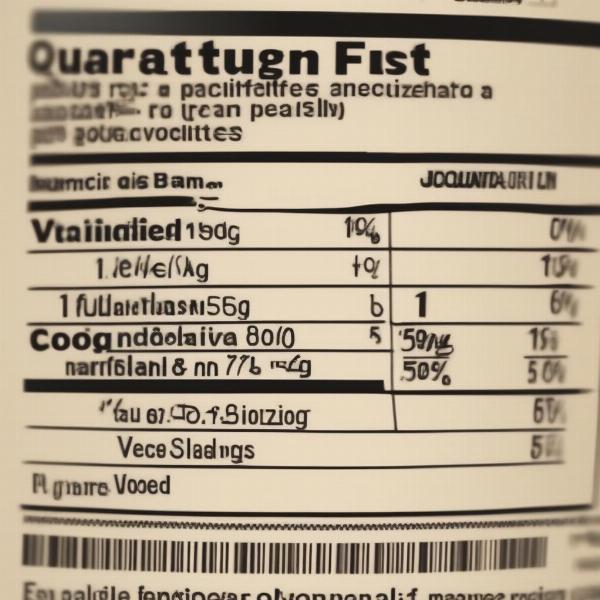Choosing the right food for your dog is a crucial decision, impacting their health, energy levels, and overall well-being. For many pet owners, grain-free dog food has become a popular choice, often perceived as a healthier alternative. But with so many brands and formulas available, finding the best rated grain-free dog food can be challenging. This guide will navigate you through the complexities of grain-free diets, helping you make informed decisions for your furry friend.
What are the benefits of a grain-free diet? Why choose grain-free over traditional kibble? And what should you look for when selecting the best rated grain-free dog food? This comprehensive guide addresses these questions and more, providing valuable insights into choosing the optimal nutrition for your canine companion. We’ll explore the pros and cons of grain-free diets, delve into ingredient lists, and discuss key considerations based on your dog’s breed, age, and activity level.
Understanding Grain-Free Dog Food
What exactly is grain-free dog food? Simply put, it’s dog food formulated without grains like wheat, corn, rice, and barley. These grains are often used as fillers in traditional dog food, providing carbohydrates for energy. Grain-free options replace these grains with alternative carbohydrate sources like potatoes, sweet potatoes, peas, lentils, or tapioca. Some pet owners choose grain-free diets believing they are closer to a dog’s ancestral diet. Others opt for grain-free due to concerns about grain allergies or sensitivities in their dogs.
Choosing the Best Rated Grain-Free Dog Food: Key Considerations
Selecting the best rated grain-free dog food requires careful consideration of various factors. Look for formulas with high-quality animal protein as the primary ingredient. This ensures your dog receives the essential amino acids they need for muscle development and overall health. Avoid foods with artificial colors, flavors, and preservatives.
What to Look for on the Label
Deciphering dog food labels can be daunting. Focus on the guaranteed analysis, which provides minimum percentages of crucial nutrients like protein, fat, and fiber. Also, examine the ingredient list. Ingredients are listed in descending order by weight, so the first few ingredients indicate the primary components of the food.
 Analyzing a dog food label
Analyzing a dog food label
Grain-Free Dog Food for Different Life Stages
A puppy’s nutritional needs differ significantly from those of an adult or senior dog. Puppies require higher levels of protein and fat to support their rapid growth and development. Senior dogs, on the other hand, may benefit from lower-calorie formulas with added joint support ingredients. horizon dog food offers a range of formulas tailored for different life stages.
Potential Concerns with Grain-Free Diets
While grain-free diets can be beneficial for some dogs, it’s important to be aware of potential concerns. Some studies have suggested a possible link between grain-free diets and dilated cardiomyopathy (DCM) in dogs. It’s crucial to discuss any dietary changes with your veterinarian, especially if your dog has pre-existing health conditions.
Making the Switch to Grain-Free
If you decide to transition your dog to a grain-free diet, do so gradually. Start by mixing a small amount of the new food with their current food, gradually increasing the proportion of grain-free food over several days. This helps prevent digestive upset and allows your dog to adjust to the new diet. gentle cold pressed dog food is known for its gentle formulation, which can be helpful during transitions.
Conclusion
Finding the best rated grain-free dog food requires research and careful consideration of your dog’s individual needs. By understanding the ingredients, potential benefits and concerns, and the importance of consulting with your veterinarian, you can make informed decisions that support your dog’s health and well-being. Remember to look for high-quality ingredients, avoid artificial additives, and transition your dog to a new diet gradually. best dog foods for goldendoodles can provide further insights into breed-specific nutritional requirements.
FAQ
- Is grain-free dog food better for all dogs? Not necessarily. While some dogs thrive on grain-free diets, others may do better with traditional formulas. Consult with your veterinarian to determine the best option for your dog.
- What are the signs of a grain allergy in dogs? Common signs include itchy skin, excessive licking or scratching, ear infections, and gastrointestinal issues.
- Are all grain-free dog foods created equal? No, the quality of grain-free dog foods varies significantly depending on the ingredients and manufacturing process.
- How can I tell if my dog is doing well on a grain-free diet? Look for signs of healthy digestion, a shiny coat, good energy levels, and healthy weight maintenance.
- Can I make homemade grain-free dog food? While possible, it’s challenging to ensure a balanced homemade diet meets all of your dog’s nutritional needs. Consult with a veterinary nutritionist before attempting homemade dog food.
- Are grain-free diets more expensive? Generally, grain-free dog foods tend to be more expensive than traditional kibble due to the higher-quality ingredients.
- Where can I find the best rated grain-free dog food? healthy dog training treats may be helpful in finding good quality training treats that also align with a grain-free diet.
ILM Dog is your trusted partner in all things canine. We provide expert advice on dog breeds, health, training, nutrition, grooming, and much more. Our mission is to empower dog owners with the knowledge and resources they need to provide their furry companions with the best possible care. For further guidance on choosing the perfect grain-free dog food for your beloved pet, including recommendations tailored to your dog’s specific needs, connect with our team of experts. Reach us at [email protected] or call us at +44 20-3965-8624. ILM Dog is here to support you and your dog every step of the way. beef and sweet potato dog food might be a good option for dogs who enjoy this flavor profile.